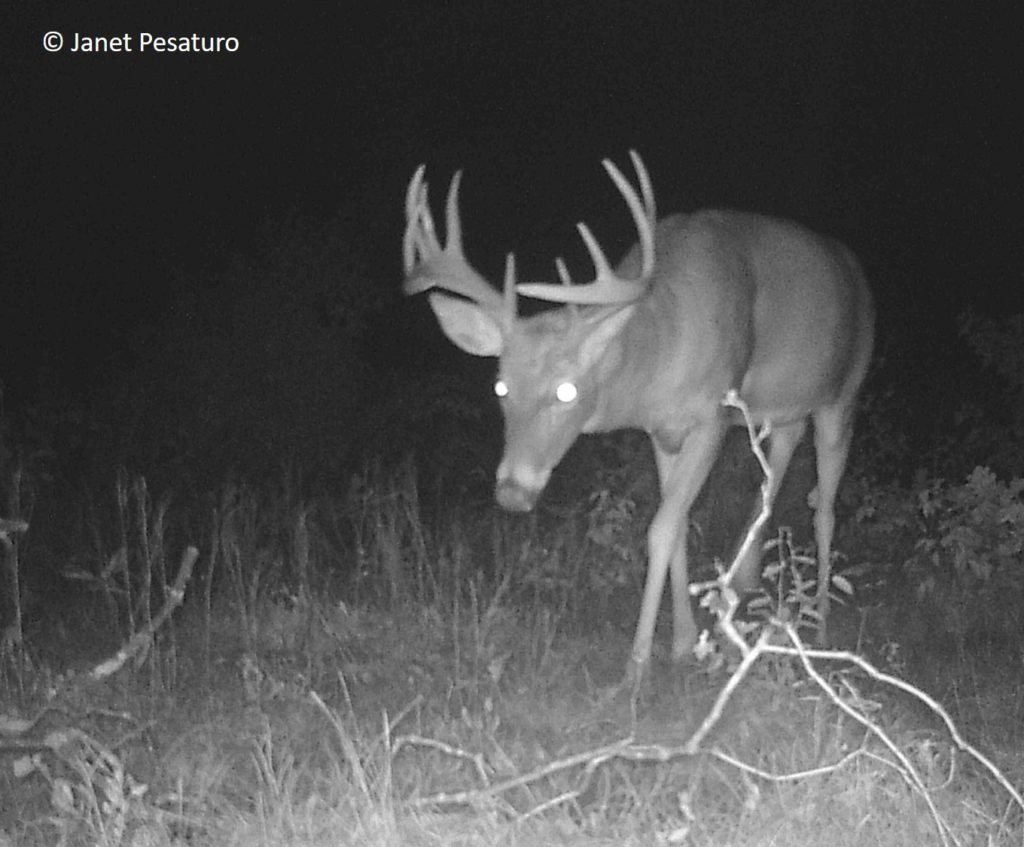White-tailed Deer Scrape Action – Video

White-tailed buck captured by camera trap.
A deer scrape is a scenting area where the animals scrape their hoofs on the ground and chew, mouth, or nose the end of a thin, low, overhanging branch. They sometimes urinate on the scrape, allowing the urine to run down the hind legs, carrying scent from the hock glands located on the insides of the legs, down to the scrape. The scrape itself appears as a 2-3 foot long oval to triangular area cleared of debris, and the branch may appear beat up.
Deer scrapes are often described as belonging to a single buck, with little mention of doe activity at the site, but this trail camera footage suggests otherwise. The camera was stationed at a scrape in Massachusetts from 9/3/2016 to 12/27/2016 and set to take 30 second videos. Several bucks and several does visited the scrape during that period. Both bucks and does mouthed and nosed the branch, though the buck did it more aggressively and for longer periods. Bucks scraped with their hooves on 2 occasions, and does never scraped. I could not tell for sure whether anyone urinated, though I believe a buck did on at least 1 occasion.
Unless the scrape I studied was an exception to the rule, scrapes aren’t owned by any one animal. They’re where multiple animals, both male and female, communicate.
When I retrieved the camera in late December, 3 things were obvious:
- As evidenced by tracks in the snow, the scrape was situated on a well-used deer run, a convenient location for communication among multiple animals
- The low branch had been broken, and was no longer within the reach of the deer.
- The scrape had been covered with leaf litter, as if it was no longer in use.
And then, when I reviewed the video clips:
- The area seemed to be a hot spot for other species as well. Coyote, bobcat, moose, and raccoons passed through multiple times. A coyote even peed near the scrape, and then plopped a scat on it.
- The reason the lower part of the overhanging branch disappeared was that a moose ate it! This was interesting in and of itself, because hemlock is not often listed as a menu item for moose.
- The largest buck tried to salvage the scrape as a scent station by standing on his hind legs to grab the shortened branch. He was able, but perhaps because the does could no longer reach it, the site lost its appeal as a scenting area. Deer continued to use their trail, but no longer stopped to mark or sniff at the scrape, and the scrape became covered with leaf litter. The timing of the loss of the branch, (November 1st), was probably the reason for the minimal scraping and urinating at this site. The rut in Massachusetts doesn’t really peak till late November, and before that, deer are probably less likely to exhibit all of the scrape related behaviors.
A note on the video: I did not include all of the clips because it would have been far too long. I selected just the highlights, representative clips, and shortened most of them, in order to get the video down to 5-6 minutes. In reality, there was more action at the scrape than what you see in the video.

Excellent, Janet. Informative footage .. and I loved the eyeball!
Thanks, Pat! I agree, the moose eye in the camera was a highlight. She looked pretty darn proud of what she had accomplished there, thwarting the deer.
Loved it! Great info about deer behavior. The close-up of the moose eye investigating your camera was funny.
Thanks, Patty! Glad you enjoyed it.
Thank you Janet – that was excellent footage! Really interesting to see both does and bucks scenting that scrape and hemlock bough. Two winters ago I came upon several moose beds in an upland forest. It looked like a pod of 4 moose had been staying in this one area for a couple of days before moving on. I spent quite a bit of time studying what they had been eating there and it turned out that in addition to striped maple twigs and buds, they were eating the terminal branches of hemlock! I too was surprised by this.
So interesting about the hemlock. Thanks for sharing your observations. I recently had a discussion with a bunch of tracking friends about whether moose eat hemlock. Most thought no, a few thought yes. And while the moose in the video ate that hemlock branch, I wonder if all the deer scent on it was part of the appeal. So they can eat it but I still wonder if it’s ever a significant portion of their diet.
Very interesting. I would actually be quite happy to watch the much longer clips to see all the activity (especially since I have nowhere good to wildlife-watch around here, so I have to do it vicariously!)
Camille, I enjoy watching the full length clips myself, but I try to keep the videos short, because I’m afraid people won’t watch them if they’re too long. It would actually be easier for me to do less editing, so maybe I’ll make a longer one for a future topic, and see what happens. Thanks for the feedback!
Very nice enjoyed it very much, great footage
Glad you enjoyed it!
That’s a great set for lots of action. Congratulations on getting such a variety of species.
Thanks. I was really surprised to see so much action there.
Janet… fantastic!!
Glad you found it useful, Terry!